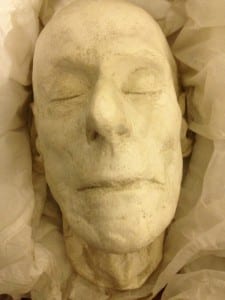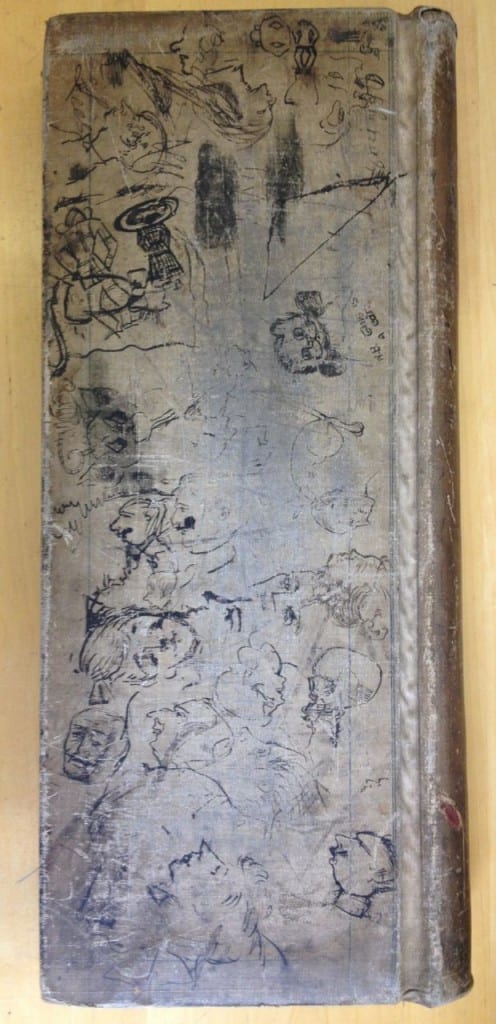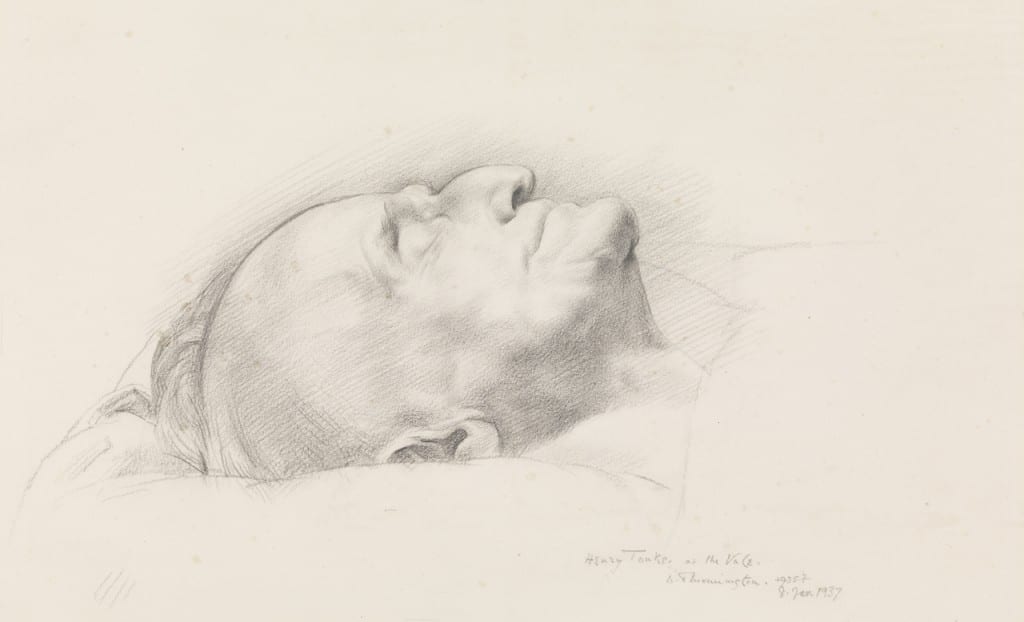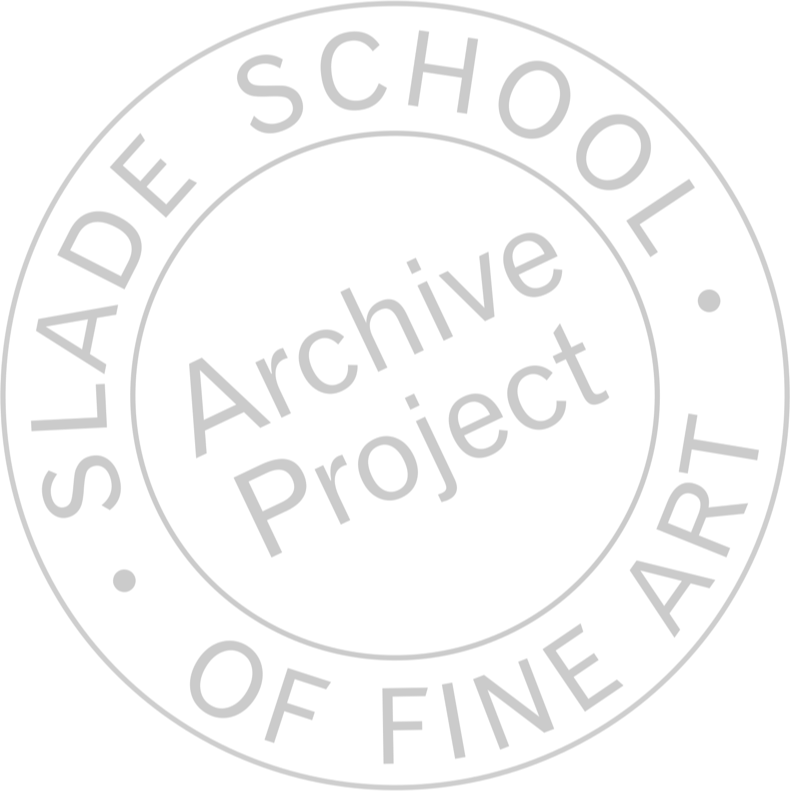Ibrahim El-Salahi
By Slade Archive Project, on 2 August 2013
‘The provision of new tropes of self-expression and self-representation that traversed frontiers of environment and geography was one of this visionary artist’s major achievements.’
Salah M. Hassan, Ibrahim El-Salahi: A Visionary Modernist p. 12.
Pioneering artist and Slade alumnus Ibrahim El-Salahi is the subject of a groundbreaking exhibition that marks the first time Tate Modern has given a retrospective to an African artist.
As a young Sudanese artist and teacher, El-Salahi was sponsored by the Sudanese Government to study at the Slade from 1954-57. Already an accomplished artist (having obtained a Diploma from Gordon Memorial College, and been appointed drawing master in the Department of Art), El-Salahi’s period at the Slade expanded his awareness of modernism and western art history. But when he returned to Sudan at the end of his studies, he encountered local indifference to the work he’d produced in London. It was a reaction that would prompt the burgeoning artist to venture into altogether new artistic territory. He began to fuse aspects of European art movements with elements of Islamic, Arabic and African art in a revolutionary re-imagining of the various artistic traditions around him. Through this cross-pollination El-Salahi become a pioneering figure in African Modernism; not only as an artist, but through his work as an activist, writer, diplomat and even as a presenter on a national television programme.
While a student at the Slade, El-Salahi won the Slade Prize ‘for the illumination of lettering’, a fitting award considering Arabic calligraphy would become a key source for much of his later work.
Ibrahim El-Salahi: A Visionary Modernist is at Tate Modern until 22 September 2013.
Both El-Salahi and his co-exhibitor at Tate Modern, Meschac Gaba, are the subject of a recent episode of The Culture Show on BBC 2, and the exhibition’s curator, Salah M. Hassan, discusses El-Salahi’s work on BBC Radio 3’s Night Waves.
Crisis of Brilliance
By Slade Archive Project, on 4 July 2013
The latest exhibition at Dulwich Picture Gallery has a lot to offer for those interested in the Slade’s history. A Crisis of Brilliance presents work by David Bomberg, Dora Carrington, Mark Gertler, Paul Nash, C.R.W. Nevinson and Stanley Spencer – a group of provocative artists who studied at the Slade from 1908-1912. The exhibition is based on a publication by David Boyd Haycock which charts the artists’ intersecting social circles to situate their developing artistic practices within their wider cultural context.
The school’s registers, or ‘singing-in books’ as they are known colloquially, have recorded the signatures of some of these well-known artists. Each register lists ladies on one side and gentlemen on the other. Over the years students have used the books to practice their sketching, as the back of this register shows. It would be quite a task to identify the artists at work (perhaps even some of the tutors pitched in?) but suggestions are welcome!
The register covers the years 1907-1909 and on the 20th January 1909 we can spot the signatures of Mark Gertler, Rudolph Ihlee, Maxwell Gordon Lightfoot, Richard Nevinson, David Sassoon and Stanley Spencer. Dora Carrington and Paul Nash would not arrive at the Slade until the following year.
The ‘signing-in’ ritual still exists. Current students are asked to log in each day as they enter the school. The books are still divided by gender as a reminder to students that they are part of a long heritage; the Slade was the first art school to admit women into the life room.
Unfortunately most of the early registers are in need of repair. The Slade does not have an archive reading room or dedicated staff to facilitate research enquiries, so it is difficult to provide public access. As part of the Slade Archive Project, we hope to undertake conservation of these treasured record books so scholars, curators, alumni and family historians can delve into their pages.
Support for Slade Oral Histories
By Slade Archive Project, on 21 June 2013
We’re delighted to announce that the Slade has recently received a grant from the Andor Charitable Trust to develop a Slade Oral History programme.
During our archive explorations, we (re)discovered an invaluable collection of oral history recordings undertaken with former students and staff. The interviews were conducted in the 1990s by the Slade’s former archivist Stephen Chaplin. These audio recordings provide fascinating insight into the impressions and experiences of former students and staff, many of who are no longer alive. However, they are now in danger of eroding and urgently require digitisation. So we appealed to the Andor Charitable Trust who has agreed that these treasures are worth saving.
Alongside our efforts to preserve the existing recordings, we hope to undertake a series of new oral history interviews. Much of what takes place in the life of an art school is conversational and informal and as a result, rarely formally documented. The use of oral history recordings will enrich our existing archive records, allowing us to capture some of these anecdotes and conversations – and help us map the networks of connections between individuals, their art practices and the wider influences that draw them together.
Preparing for the Chelsea Arts Ball, 1926
By Slade Archive Project, on 8 May 2013
It became known for its exuberance, excess and glamour, but the Chelsea Arts Ball had a modest beginning in 1908 as an annual fundraiser for the newly founded Arts Club. By the time it moved to the Royal Albert Hall in 1910, its place in the London social calendar was set – and London’s art school students led the way.
Held on New Year’s Eve, the Ball was given a new theme each year. Elaborately dressed art students represented their schools with extravagantly decorated floats that were driven directly into the Albert Hall, only to be destroyed by the revelers at the stroke of midnight. A short clip from Pathé’s archive, showing the 1954 ball in full swing, sets the scene.
It’s hard to spot Slade students in the Pathé archive, but a generation earlier someone was savvy enough to take this photograph outside the Slade, as a group of students test run their gallant personas in preparation for the 1926 Ball. The label on the back of the photo doesn’t explain what theme is being enacted here (though we might hazard a guess), but it does identify one notable figure in the group: William Coldstream, who can be spotted by his fashionable symmetrical fringe (centre of photograph, left of horseman).
Coldstream was a first-year student at the time of the 1926 ball. He would go on to marry (and later divorce) fellow student Nancy Sharp and, in 1937, co-found the influential Euston Road School with fellow Slade alumni Claude Rogers and Graham Bell. After service in the War, he worked briefly for the GPO Film Unit and taught at Camberwell College of Arts and Crafts before being appointed Slade Professor in 1949, a post he would hold until his retirement in 1975.
A horse in the studio
By Slade Archive Project, on 26 March 2013
What is a horse doing in the studio? The memoirs of Jessie Hall, a young student studying at the Slade in 1885, help explain. Now housed in UCL Special Collections (and charmingly titled My Year at the Slade School: The very happiest year of my life! Shall I let it pass unrecorded? No! The poorest moments of it were better than letting it sink into oblivion!), Hall’s memoirs describe one particular assignment in the life drawing room:
“A Horseman Bringing News of a Battle to the Inhabitants of a City”, that was the subject for this month and I made up my mind to do it. The model was posed in various positions … one position one day, another the next, sometimes the same model for the different poses, sometimes the model was changed. I wondered what we were to do about the horse for the horseman, and imagined that we would have some of the equine plaster casts up for the occasion.
I was agreeably surprised! We were told to go down to the Lower Life [room] one afternoon, where the men students studied, where one side of the room had a paved floor and a huge pair of double doors to enable animals to be brought in as models from the livery stables behind the College. There stood a live horse as a model! It is not easy to draw a horse in 20 minutes. Sketching as fast as my poor powers would let me, I never could get the legs in.
Hall Biography, 1924, p.4, UCL Special Collections, MS ADD 327
Hall’s accounts – rich with detail of the day-to-day life of the Slade student – recall the students’ nervousness as the tutors inspected their work, with particular awe for the ‘prophetic eye’ of the Slade Professor Alphonse Legros. She lists the subjects studied in the Antique Room, describes the smell of warm paint infused by the water pipe heating system in the life room; of being selected by the Professor to sit in the best seat in the Life Room; and of working through the weekend to prove she was much more than a dilettante.
Global mapping & uncharted territories
By Slade Archive Project, on 19 March 2013
The legacy of noted figures like Henry Tonks has been well documented, but what about students who came from afar and left the UK when their studies ended? Where did Slade students come from and where did they go on to base their practice? What impact have they had on art worlds internationally? What influences and inspiration did they take with them from their time at the Slade? What connections can be drawn between Slade archive materials and the living histories of artists from around the world? How do we draw these materials together and make them accessible to scholars, curators, family historians, and alumni?
Through the Slade Archive Project we hope to chart some of the lesser-known histories of the school, and trace the footpaths of those artists from cultures and countries beyond the UK, where language barriers, large distances and in some instances, contested artistic traditions, have historically limited an exchange of information. We are delighted to announce that Dr Amna Malik, Lecturer in History and Theory of Art at the Slade, has recently been awarded a UCL Grand Challenges Intercultural Interaction grant to work with Dr Melissa Terras (UCL Centre for Digital Humanities) to begin this research by tracing the influence of artists and Slade alumni, Ibrahim El Salahi (b. 1932 Sudan) and Khalid Iqbal (1929-2014 Pakistan). Iqbal studied at the Slade between 1952-1955 and El Salahi between 1956-1959 and both then went on to have pioneering roles in the development of art and art education in their respective countries, an aspect of the international impact of the Slade that has yet to be mapped. Stay tuned!
Unlikely objects in the archive
By Slade Archive Project, on 6 March 2013
Archives can contain all manner of unlikely odds and ends. As a Research Assistant on the Slade Archive project, I have been charged with the task of scoping the archive to determine what can be made more publicly accessible. Walking into the archives for the first time, I came across this surprise: a death mask of former Slade Professor Henry Tonks (1862–1937).
 Tonks was a painter and draughtsman with a reputation for being a fierce but highly influential presence at the Slade. A surgeon by training, he had a successful career at Royal Free Hospital in London before being invited to join the teaching staff at the Slade in 1893 by Frederick Brown, then Principal of the School. Tonks’ understanding of anatomy and his fine draughtsmanship are legendary and his teachings are said to have impacted notable students such as Augustus John, Stanley Spencer, Wyndham Lewis, Mark Gertler and Rex Whistler.
Tonks was a painter and draughtsman with a reputation for being a fierce but highly influential presence at the Slade. A surgeon by training, he had a successful career at Royal Free Hospital in London before being invited to join the teaching staff at the Slade in 1893 by Frederick Brown, then Principal of the School. Tonks’ understanding of anatomy and his fine draughtsmanship are legendary and his teachings are said to have impacted notable students such as Augustus John, Stanley Spencer, Wyndham Lewis, Mark Gertler and Rex Whistler.
According a the story still told at the Slade, it was William Coldstream (1908-1987) and Walter Thomas Monnington (1902-1976) who cast this mask shortly after Tonks’ death in 1937. Understandably squeamish what was involved in making the mask, they fortified themselves with drink to the extent that they made a quite a mess during the casting process … or so the story goes. Besides showing how informal oral histories can work alongside archive objects to shed light on the personalities and events behind the Slade’s history, this mask is an example of just how many connections can be drawn through the various Slade archive materials held within UCL: there is a bronze bust of Tonks sitting proudly in the Housman Room at UCL, various photographic portraits of him in the Slade archive, some of his artworks in UCL Art Museum and his papers in UCL Special Collections – and this posthumous portrait by Walter Thomas Monnington, also in the collection of UCL Art Museum – which provides a curious counterpoint to the mask in the archive.
I have a few photos …
By Slade Archive Project, on 27 February 2013
We receive many requests for photographs of former staff and students of the Slade – from art historians and filmmakers, to members of the public tracing their family history – hoping to locate some images for their project. So it’s particularly exciting when an email or letter arrives from people wanting to contribute their photos and memories to the archive.
Slade alumna Susan Glasspool, who studied at the Slade from 1963-66, sent in these images. She recalls receiving a copy of this first photo through the Secretary’s office because it her 3-D lithographs appeared in the background. Professor William Coldstream (front left), Andrew Forge (top left) and William Townsend (right of Forge) represent the Slade at this gathering in 1966, which is thought to be the Slade Diploma Examinations Committee.
Another photo, taken on the stairs just inside the entrance of the Slade, shows (L-R) Rosemary Johnson, Susan Glasspool, Antonia Frazer and two other unidentified students.
Most often, we don’t know much about the who, what, where, when and why behind these images. If you can assist us in contextualizing or identifying people in these photographs, please do get in touch: slade.enquiries@ucl.ac.uk.
UPDATED 18 March 2013: Paul Martin has identified the two other sitters on the Slade steps as Diane Shorrock and Jane Ford (far right).
What does the Slade Archive look like?
By Slade Archive Project, on 13 February 2013
Here is a little peek behind the scenes in the archives. The ‘Slade Archive’ is in fact not a single archive, but is made up of four collections which have been dispersed across UCL; there are materials held in UCL Special Collections and UCL Records Office, UCL Art Museum and within the Slade building itself, so the shelves you see here hold only one part of this rich collection.
As of yet, little has been done to digitize and link these collections online. Even more, there are materials here in dire need of repair and conservation before digitization can take place. Through the Slade Archive Project, we hope to develop plans for its future care, but also gather new information, accounts, photographs and other documents from former students, staff and scholars and create online resources for alumni, scholars and family historians which will trace the movement and impact of former Slade students and generate new research about the School and its ongoing legacy.
Introducing the Slade Archive Project
By Alejandro Giacometti, on 10 December 2012
Since 1871 the Slade School of Fine Art has educated and trained generations of world-renowned artists, from Gwen and Augustus John, Stanley Spencer and Ben Nicholson around the turn of the 20th century and early 1900s, to William Coldstream, Richard Hamilton and Eduardo Paolozzi in the 1930s and 40s, through to Derek Jarman, Paula Rego, Euan Uglow and Craigie Aitchison in the 50s and 60s. More recent Turner Prize winning alumni include Martin Creed, Rachel Whiteread, Antony Gormley and Douglas Gordon.
The Slade has an extensive archive on site which includes objects, papers, photographs, class lists, student records and artefacts dating throughout its history at UCL. Together with materials held in UCL Special Collections and UCL Art Museum, the archive collection contains rich evidence of the time artists spent at the Slade. Much of this archive, however, is difficult to access, and the Archive Project is aimed at exploring ways of presenting this information to a wider audience.
UCL’s Centre for Digital Humanities has received a UCL Arts & Humanities Small Research Grant to work with the Slade to undertake a pilot project on the Slade Archive – to start mapping and activating this invaluable resource. Over the months to come we will explore ways in which this underused resource can be made more accessible and generate new knowledge – through new research, online resources, public events and publications. The project will trial various online platforms and tools to help unearth, track and bridge together the varied histories of the School, its former staff and students, and chart their impact in the art world – both nationally and internationally.
For more information contact:
Slade Archive Project slade.enquiries@ucl.ac.uk
Slade School of Fine Art
UCL Centre for Digital Humanities
UCL Special Collections
UCL Art Museum
 Close
Close











